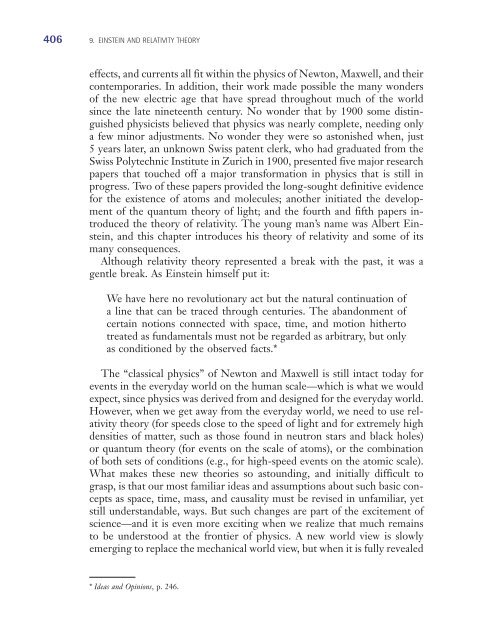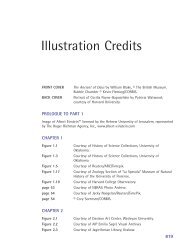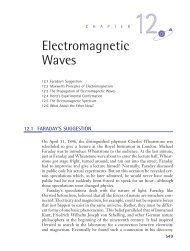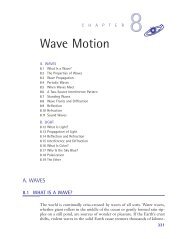Chapter 9: Einstein and Relativity Theory (319 KB) - D Cassidy Books
Chapter 9: Einstein and Relativity Theory (319 KB) - D Cassidy Books
Chapter 9: Einstein and Relativity Theory (319 KB) - D Cassidy Books
You also want an ePaper? Increase the reach of your titles
YUMPU automatically turns print PDFs into web optimized ePapers that Google loves.
3637_<strong>Cassidy</strong>TX_09 6/14/02 12:08 PM Page 406<br />
406 9. EINSTEIN AND RELATIVITY THEORY<br />
effects, <strong>and</strong> currents all fit within the physics of Newton, Maxwell, <strong>and</strong> their<br />
contemporaries. In addition, their work made possible the many wonders<br />
of the new electric age that have spread throughout much of the world<br />
since the late nineteenth century. No wonder that by 1900 some distinguished<br />
physicists believed that physics was nearly complete, needing only<br />
a few minor adjustments. No wonder they were so astonished when, just<br />
5 years later, an unknown Swiss patent clerk, who had graduated from the<br />
Swiss Polytechnic Institute in Zurich in 1900, presented five major research<br />
papers that touched off a major transformation in physics that is still in<br />
progress. Two of these papers provided the long-sought definitive evidence<br />
for the existence of atoms <strong>and</strong> molecules; another initiated the development<br />
of the quantum theory of light; <strong>and</strong> the fourth <strong>and</strong> fifth papers introduced<br />
the theory of relativity. The young man’s name was Albert <strong>Einstein</strong>,<br />
<strong>and</strong> this chapter introduces his theory of relativity <strong>and</strong> some of its<br />
many consequences.<br />
Although relativity theory represented a break with the past, it was a<br />
gentle break. As <strong>Einstein</strong> himself put it:<br />
We have here no revolutionary act but the natural continuation of<br />
a line that can be traced through centuries. The ab<strong>and</strong>onment of<br />
certain notions connected with space, time, <strong>and</strong> motion hitherto<br />
treated as fundamentals must not be regarded as arbitrary, but only<br />
as conditioned by the observed facts.*<br />
The “classical physics” of Newton <strong>and</strong> Maxwell is still intact today for<br />
events in the everyday world on the human scale—which is what we would<br />
expect, since physics was derived from <strong>and</strong> designed for the everyday world.<br />
However, when we get away from the everyday world, we need to use relativity<br />
theory (for speeds close to the speed of light <strong>and</strong> for extremely high<br />
densities of matter, such as those found in neutron stars <strong>and</strong> black holes)<br />
or quantum theory (for events on the scale of atoms), or the combination<br />
of both sets of conditions (e.g., for high-speed events on the atomic scale).<br />
What makes these new theories so astounding, <strong>and</strong> initially difficult to<br />
grasp, is that our most familiar ideas <strong>and</strong> assumptions about such basic concepts<br />
as space, time, mass, <strong>and</strong> causality must be revised in unfamiliar, yet<br />
still underst<strong>and</strong>able, ways. But such changes are part of the excitement of<br />
science—<strong>and</strong> it is even more exciting when we realize that much remains<br />
to be understood at the frontier of physics. A new world view is slowly<br />
emerging to replace the mechanical world view, but when it is fully revealed<br />
* Ideas <strong>and</strong> Opinions, p. 246.






